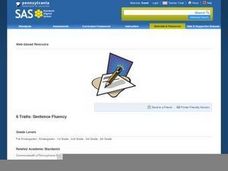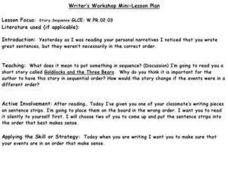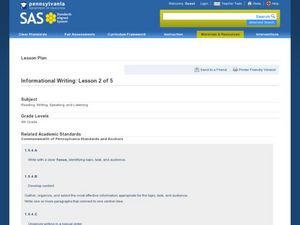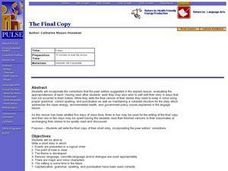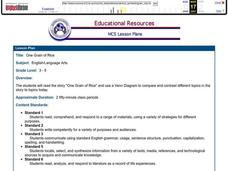For the Teachers
Story Strips Sequencing
What happens next? Work on story sequence with a lesson that prompts kids to put a story back in order. Additionally, they discuss what would happen if one event was missing from the sequence.
For the Teachers
Sequence Plot Chart
Your kids can identify the plot sequence of a short story, but what about an informational article? Have them examine the chronological order of events in informational texts with a activity on the sequence of events.
Curated OER
Logical Sequence
Students examine logical and illogical sequences in writing. They identify illogical sequences of sentences in a letter. Students retell short stories using a logical sequence and students place sentences in logical order.
Virginia Department of Education
Creating Thesis Sentences
Growing writers explore what it takes to develop and support a thesis statement with pre-fabricated ideas provided by the Virginia Department of Education. Learners take notes on what makes a thesis statement and a topic sentence, and...
Pennsylvania Department of Education
6 Traits: Sentence Fluency
Students practice writing with sentence fluency in order to make the story more enjoyable for the reader. In this sentence fluency lesson plan, students focus on rhythm and flow.
Curated OER
Sunrise Sequencing
Students examine sequencing events by discussing what they do each morning. They complete a four-panel sequence of events assignment, drawing a picture and writing a sentence for each box in the panel.
Curated OER
Writers Workshop Story Sequence
Students read stories and explore the importance of sequential order. In groups, students are given sentence strips. Students holding the sentence strips, place themselves in a logical order to make a story. Individually, students...
Curated OER
Fun with Making Sentences
Students develop their own children's book in order to develop writing skills. The skills include writing logical and complete sentences. This lesson is important because writing is applicable to many subject areas.
Think Like A Programmer! Puzzlets Cork the Volcano Curriculum
Common Core Standards Connected
The standards listed below are standards from the Common Core Framework which map to learning opportunities with Cork The Volcano & Puzzlets.
Source Link:...
Pennsylvania Department of Education
Informational Writing: Lesson 2 of 5
Introduce expository writing to your elementary learners. Young authors write a three-paragraph informational paper using the steps of the writing process. They follow guided lessons to experience each of five steps. Included are tons of...
For the Teachers
Cause and Effect Matrix
Study cause and effect in both literature and informational text with a instructional activity designed for several different reading levels. After kids review the concept of cause and effect, they read an article or story and note the...
Pennsylvania Department of Education
6 Traits: Organization
Students make logical patterns in their writing to demonstrate the trait of organization. In this organization lesson plan, students focus on events proceeding logically.
Curated OER
The Grouchy Ladybug
Students complete a Cirlce Map about time. They recall times during the grouchy ladybugs travels, and add dots on ladybugs using turn-around facts. Pupils correctly sequence the events of The Grouchy Ladybug. Students compose new...
Pennsylvania Department of Education
Analyzing Key Ideas and Details in Nonfiction
Learners explore nonfiction texts. In this language arts lesson, students read a nonfiction text and make predictions. Learners identify facts and opinions in the text and draw conclusions as they read.
Curated OER
Three Reasons Why I Want To Be...
Pupils investigate the process of writing an expository paper. The purpose of the paper is established in the introduction and the supporting details are sequenced in a logical order. The paper possesses punctuation and grammatical style...
Curated OER
Fire Escape Plan
Students explore fire safety. In this fire prevention and safety instructional activity, students discuss and brainstorm ideas about what to do if there is a fire. Students practice stating information that should be given when calling...
Curated OER
The Final Copy
Write short stories in which events are presented in logical order, point of view is clear, theme and characters are developed. Middle schoolers also work on sensory language, concrete language and/or dialogue. They establish their...
Curated OER
Getting to Know You
After going over the five steps of the writing process, pupils fill out "Getting to Know You" worksheets. They trade papers with each other, and have the task of writing a descriptive paragraph about the person whose worksheet they...
Curated OER
One Grain of Rice
Upper graders read the story One Grain of Rice, and use a Venn diagram to compare and contrast topics found in the story to current event topics today. Groups of three learners work together to create their diagram. The topics they must...
Curated OER
The Day Jimmy's Boa Ate the Wash
Students read the story The Day Jimmy's Boa At the Wash and put the event boxes in order from the beginning to end of the story. In this sequencing lesson plan, students do this on the computer.
Curated OER
Narrative Writing
A perfect nonfiction writing activity for the beginning of the year, the Life Line helps you get to know your pupils better and helps the children get to know one another. Later in the year the Star of the Week writing activity...
Curated OER
Look It Up!
Sixth graders improve their writing skills by finding, defining, and correctly using new and interesting vocabulary words. Groups of students work together to find, define, and use in sentences ten words with which they are all unfamiliar.
Curated OER
How can we write a silly story?
Second graders use the writing process and create a silly story. In this silly story instructional activity, 2nd graders will review person, event and setting and complete a chart for each. Students will put a person,...
Curated OER
All About Me!
Students write about themselves. In this descriptive writing lesson, students view a PowerPoint for examples of descriptive writing and then write sentences describing themselves. Students use a computer program to type their sentences...




